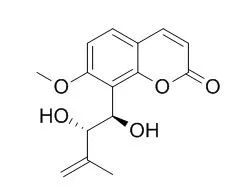| Cancer Lett. 1999 Apr 26;138(1-2):87-92. |
| Anti-tumor-promoting effects of 8-substituted 7-methoxycoumarins on Epstein-Barr virus activation assay.[Pubmed: 10378778 ] |
METHODS AND RESULTS:
In a search for anti-tumor-promoting agents, we carried out a primary screening of twenty-nine 8-substituted and four 6-substituted derivatives of 7-methoxycoumarins isolated from plants of the Murraya and/or Citrus species (Rutaceae), examining their possible inhibitory effects on Epstein-Barr virus early antigen (EBV-EA) activation induced by 12-O-tetradecanoylphorbol-13-acetate (TPA) in Raji cells. This investigation indicated that the prenyl (3-methyl-2-butenyl) or 2-hydroxy-3-methylbutyl (or butenyl) unit as an isoprenoid moiety at C-8 on the 7-methoxycoumarin nucleus plays an important role in the anti-tumor-promoting activity.
CONCLUSIONS:
Some of the 8-substituted 7-methoxycoumarins isolated from Murraya species, murrangatin (7), Minumicrolin (10) and chloticol (18), were found to significantly inhibit EBV-EA activation, and preserved the high viability of Raji cells, suggesting that 7, 10 and 18 might be valuable anti-tumor-promoting agents. |
| J Asian Nat Prod Res. 2008 May-Jun;10(5-6):515-9. |
| Two new coumarins from Murraya paniculata.[Pubmed: 18470803 ] |
METHODS AND RESULTS:
Two new coumarins, murrmeranzin (1) and murralonginal (2), together with four known compounds Minumicrolin (3), murrangatin (4), meranzin hydrate (5) and hainanmurpanin (6) have been isolated from the aerial parts of Murraya paniculata. The structures of these compounds were determined through spectral analysis.
CONCLUSIONS:
Minumicrolin (3) showed mild butyrylcholinesterase inhibition activity. |
| Biosci Biotechnol Biochem. 2000 Feb;64(2):420-3. |
| Coumarin-related compounds as plant growth inhibitors from two rutaceous plants in Thailand.[Pubmed: 10737204 ] |
METHODS AND RESULTS:
Chemical investigation of naturally occurring plant growth inhibitors from Rutaceous plants in Thailand led us to identify five 7-methoxycoumarins and one 5,7-dimethoxycoumarin from Murraya paniculata, and six furanocoumarins from Citrus aurantifolia.
CONCLUSIONS:
Of these compounds, murranganon senecioate (1) is a new natural compound found in M. paniculata.
Minumicrolin (6) was found to be highly active against the 2nd leaf sheath elongation of rice seedlings. |






 Cell. 2018 Jan 11;172(1-2):249-261.e12. doi: 10.1016/j.cell.2017.12.019.IF=36.216(2019)
Cell. 2018 Jan 11;172(1-2):249-261.e12. doi: 10.1016/j.cell.2017.12.019.IF=36.216(2019) Cell Metab. 2020 Mar 3;31(3):534-548.e5. doi: 10.1016/j.cmet.2020.01.002.IF=22.415(2019)
Cell Metab. 2020 Mar 3;31(3):534-548.e5. doi: 10.1016/j.cmet.2020.01.002.IF=22.415(2019) Mol Cell. 2017 Nov 16;68(4):673-685.e6. doi: 10.1016/j.molcel.2017.10.022.IF=14.548(2019)
Mol Cell. 2017 Nov 16;68(4):673-685.e6. doi: 10.1016/j.molcel.2017.10.022.IF=14.548(2019)